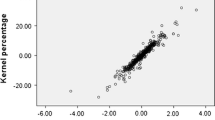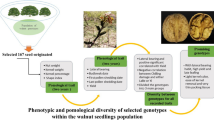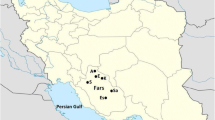Abstract
About 130 seed-propagated walnut trees (Juglans regia L.) grown in the same location were evaluated for 2 years based on 37 quantitative and qualitative traits. The late-leafing trait ranged between 1 April and 14 April (13–27 days after Payne). The first female and male flowering dates ranged from 8 April to 5 May and from 7 to 29 April, respectively. The protandrous, protogynous, and homogamous percentages were 46.72%, 35.24%, and 18.03%, respectively. The harvest time changed from 7 September to 27 September. The bearing type rates were 3.5% for lateral, 13.4% for terminal, and 83.1% for both. The severity of blight and anthracnose disease varied from very low to very severe. The annual growth varied from 3.9 cm to 45.7 cm, while the leaf area ranged from 24.3 cm2 to 48.01 cm2. All types of tree growth habit were observed among the studied genotypes, with the spreading type predominating. The ranges of the fruit attributes were 1.4 mm –5.7 mm for husk thickness, 0.7 mm –2.3 mm for shell thickness, 25.4 mm –41.5 mm for nut length, 25.7 mm –38.5 mm for nut width, 7.27 g –17.73 g for nut weight, 3.68 g –9.49 g for kernel weight, 45.48%–63.86% for kernel percentage, and extra light to amber for kernel color. The highest recorded apomixis rate of the 30 genotypes was 25.55%, whereas this rate was low or even zero in some genotypes. In conclusion, the high diversity found in the studied germplasm resulted in the selection of some superior genotypes that can be considered promising plant materials for future walnut breeding programs.







Similar content being viewed by others
References
Ahandani EA, Ramandi HD, Sarmad J, Samani MA, Yavari A (2014) Evaluation of morphological diversity among somepersian walnut accessions (Juglans regia L.) in Guilan, Northern Iran. Int J Plant Biol Res 2(3):10–15
Akça Y, Ozongun S (2004) Selection of late leafing, late flowering, laterally fruitful walnut (Juglans regia) types in Turkey. N Z J Crop Hortic Sci 32(4):337–342
Akça Y, Sen MS (1995) The relationship between dichogamy and yield-nut characteristics in Juglans regia L. In: III International Walnut Congress, vol 442, pp 215–216
Akça Y, Sen SM (2001) Study on the selection of superior walnut trees in Hizan (Bitlis) populations. Acta Hortic 544:115–118
Akça Y, Bilgen Y, Ercisli S (2015) Selection of superior persian walnut (Juglans regia L.) from seedling origin in Turkey. ACTA Sci Polonorum Hortic 14(3):103–114
Arzani K, Mansouri-Ardakan H, Vezvaei A, Roozban MR (2008) Morphological variation among persian walnut (Juglans regia) genotypes from central Iran. N Z J Crop Hortic Sci 36(3):159–168. https://doi.org/10.1080/01140670809510232
Asma B (2012) Pomological and phenological characterization of promising walnut (Juglans regia L.) genotypes from Malatya, Turkey. Acta Sci Pol Hortorum Cultus 11(4):169–178
Aysen KOC, Keles H, Ercisli S (2019) Some pomological properties of promising seed propagated walnut genotypes from inner Turkey. Notulae Bot Horti Agrobot Cluj Napoca 47(4):1094–1099
Bayazit S, Kazan K, Gülbitti S, Cevik V, Ayanoğlu H, Ergül A (2007) AFLP analysis of genetic diversity in low chill requiring walnut (Juglans regia L.) genotypes from Hatay, Turkey. Sci Hortic 111(4):394–398
Botu M, Tudor M, Papachatzis A (2010) Evaluation of some walnut cultivars with different bearing habits in the ecological conditions of Oltenia–Romania. Acta Hortic 861:119–126
Bujdosó G, Fodor A, Karacs-Végh A (2020) BD6 Walnut. HortScience 55(8):1393–1394. https://doi.org/10.21273/HORTSCI15148-20
Bükücü Ş, Özcan A, Sütyemez M, Yildirim E (2020) Determınation in the phenological difference levels of seedlings of some walnut genotypes (Juglans regia L.). Appl Ecol Environ Res 18(3):4807–4815
Chen L, Ma Q, Chen Y, Wang B, Pei D (2014) Identification of major walnut cultivars grown in China based on nut phenotypes and SSR markers. Sci Hortic 168:240–248
Cosmulescu S (2013) Phenotypic diversity of walnut (Juglans regia L.) in Romania-opportunity for genetic improvement. South Western J Hortic Biol Environ 4(2):117–126
Cosmulescu S, Botu M (2012) Walnut biodiversity in south-western Romania resource for perspective cultivars. Pak J Bot 44(1):307–311
Cosmulescu S, Stefanescu D (2018) Morphological variation among persian walnut (Juglans regia) genotypes within the population and depending on climatic year. Sci Hortic 242:20–24
Cosmulescu S, Botu M, Trandafir I (2010) Mineral composition and physical characteristics of walnut (Juglans regia L.) cultivars originating in Romania. Selcuk Tarım Gıda Bilim Derg 24:33–37
Cosmulescu S, Stefanescu D, Ionescu MB (2017) Genetic diversity among juglans regia genotypes based on morphological characters of nut. Erwerbs-Obstbau 60(2):137–143. https://doi.org/10.1007/s10341-017-0347-5
Ebrahimi A, FttahiMoghadam M, Zamani Z, Vahdati K (2010) An investigation on genetic diversity of 608 Persian walnut accessions for screening of some genotypes of superior traits. Iran J Hortic Sci 40(4):83–94
FAO (2020) FAO statistical yearbook. Agricultural production. Food and Agriculture Organization of the United Nations. http://faostat.fao.org/site/291/default.aspx. Accessed 17 Feb 2022
Fatahi R, Ebrahimi A, Zamani Z (2010) Characterization of some Iranians and foreign walnut genotypes using morphological traits and RAPD markers. Hortic Environ Biotechnol 51(1):51–60
Forde HI (1975) Walnuts, pp 439–455
Guo-Liang W, Yan-Hui C, Peng-Fei Z, Jun-Qiang Y, Yu-Qin S (2007) Apomixis and new selections of walnut. Acta Hortic 760(2):541
Guo-liang W, He L, Qunlong L, Yong W, Pengfei Z (2010) ‘Qinquan 1’, a new apomixis walnut cultivar. Fruits 65(1):39–42
Haghjooyan R, Ghareriazi B, Sanei-Sharuat-Panahi M, Khalighy A (2005) Investigation Genetic Diversity of Walnut Genotype in Different Region of Country by Quantaitives Morphological Marker. Pajhoohesh and Sazandegi, No 69
Hakan K, Akça Y (2011) Phenological and pomological properties of promising walnut (Juglans regia L.) genotypes from selected native population in Amasya Province. African J Biotechnol Vic Isl 10(74):16763–16768
Hansche PE, Beres V, Forde HI (1972) Estimated of quantitative genetic properties of walnut and their implications for cultivar improvement. Am Soc Hort Sci J 97:279–285
Hassani D, Aqaei MJ, Dastjerdi R, Sorkhi B, Damyar S (2011) Guideline for evaluation and determination of factors causing damages in walnut orchards
Hassani D, Atefi J, Haghjooyan R, Dastjerdi R, Keshavarzi M, Mozaffari MR, Malmir A (2012a) Cultivar release: damavand, a new persian walnut cultivar as a pollinizer for Iranian walnut cultivars and genotypes, cultivar. Seed Plant Improv J 28(3):529–531
Hassani D, Mozaffari MR, Soleimani A, Dastjerdi R, Rezaee R, Keshavarzi M, Atefi J (2020) Four new Persian walnut cultivars of Iran: persia, caspian, chaldoran, and alvand. HortScience 55(7):1162–1163
Hayes D, Angove MJ, Tucci J, Dennis C (2016) Walnuts (Juglans regia) chemical composition and research in human health. Crit Rev Food Sci Nutr 56(8):1231–1241
IPGRI (1994) Descriptors for walnut (Juglans spp.). International Plant Genetic Resources Institute, Rome
Jacimovic V, Adakalić M, Ercisli S, Božović D, Bujdoso G (2020) Fruit quality properties of walnut (Juglans regia L.) genetic resources in Montenegro. Sustainability 12(23):9963
Karadağ H, Akça Y (2011) Phenological and pomological properties of promising walnut (Juglans regia L.) genotypes from selected native population in Amasya Province. Afr J Biotechnol 10(74):16963–16968
Keles H, Akca Y, Ercisli S (2014) Selection of promising walnut genotypes (Juglans regia L.) from inner Anatolia. Acta Sci Pol Hortorum Cultus 13(3):167–173
Keramatlou I, Sharifani M, Sabouri H, Alizadeh M, Kamkar B (2015) A simple linear model for leaf area estimation in Persian walnut (Juglans regia L.). Sci Hortic 184:36–39
Korac M, Cerovic S, Golosin B, Miletic R (1997) Collecting, evaluation and utilization of walnut (Juglans regia L.) in Yugoslavia. Plant Genet Res Newsl 111:72–74
Laiko RE (1990) Apomixis of walnut. Acta Hortic 284:233–236
Liu B, Zhao D, Zhang P, Liu F, Jia M, Liang J (2020) Seedling evaluation of six walnut rootstock species originated in China based on principal component analysis and cluster analysis. Sci Hortic 265:109212
Mahmoodi R, Dadpour MR, Hassani D, Zeinalabedini M, Vendramin E, Micali S, Nahandi FZ (2019) Development of a core collection in Iranian walnut (Juglans regia L.) germplasm using the phenotypic diversity. Sci Hortic 249:439–448
Matthäus B, Özcan MM, Al Juhaimi F, Adiamo OQ, Alsawmahi ON, Ghafoor K, Babiker EE (2018) Effect of the harvest time on oil yield, fatty acid, tocopherol and sterol contents of developing almond and walnut kernels. J Oleo Sci 67(1):39–45
McGranahan G, Leslie C (2004) Robert Livermore’, a Persian walnut cultivar with a red seedcoat. HortScience 39(7):1772
McGranahan G, Leslie C (2009) Breeding walnuts (Juglans regia). In: Breeding plantation tree crops: temperate species. Springer, New York, pp 249–273
McGranahan GH, Leslie C (1990) Walnuts (Juglans). Genet Resour Temp Fruit Nut Crop 290:907–974
McGranahan GH, Leslie C (2012) Walnut. In: Badenes M, Byrne D (eds) Fruit breeding. Springer, Berlin Heidelberg
McGranahan GH, Voyiatzis DG, Catlin PB, Polito VS (1994) High pollen loads can cause pistillate flower abscission in walnut. J Am Soc Hortic Sci 119:505–509
McGranahan GH, Charles A, Leslie CA, Philips HA, Dandaker A (1998) Propagation. In: Walnut production manual
Mousavi SA, Tatari M, Moradi H, Hasani D (2015) Evaluation of genetic diversity among the superior walnut genotypes based on pomological and phenological traits in Chahar Mahal va Bakhtiari province. Seed Plant Improv J 31(2):365–389
Oguz Hİ, Aşkın A (2007) A study on the selection of walnut (Juglans regia L.) in Ermenek. YYU J Agric Sci 17(1):21–28
Özcan M (2009) Some proximate characteristics of fruit and oil of walnut (Juglans regia L.) growing in Turkey. Iran J Chem Chem Eng 28(1):57–62
Özcan MM, Lemiasheuski V (2020) The effect of harvest times on mineral contents of almond and walnut kernels. Erwerbs-Obstbau 62(4):455–458
Pinney K, Labavich J, Polito VA (1998) Fruit growth and development. In: Walnut production manual. University of California Division of Agriculture and Natural Resources, Publication No. 3373, pp 139–143
Polito V (1998) Floral biology: flower structure, development and pollination. In: Walnut Production Manual. University of California. Division of Agriculture and Natural Resources. Publication, 3373, pp 127–132
Pop FI, Vicol CA, Botu M, Raica AP, Vahdati K, Pamfila D (2013) Relationships of walnut cultivars in a germplasm collection: Comparative analysis of phenotypic and molecular data. Sci Hortic 153:124–135
Rezaei R, Hasani G, Hasani D, Vahdati D (2008) Morphological characteristics of some newly selected walnut genotypes from seedling collection in Kahriz-Orumia. Iran J Hortic Sci Technol 9(3):205–214 (https://www.sid.ir/en/journal/ViewPaper. aspx?id=151927)
Rezaei Z, Khadivi A, ValizadehKaji B, Abbasifar A (2018) The selection of superior walnut (Juglans regia L.) genotypes as revealed by morphological characterization. Euphytica 214(4):69
Salejda AM, Janiewicz U, Korzeniowska M, Kolniak-Ostek J, Krasnowska G (2016) Effect of walnut green husk addition on some quality properties of cooked sausages. LWT Food Sci Technol 65:751–757
Şan B, Dumanoğlu H (2006) Determination of the apomictic fruit set ratio in some Turkish walnut (Juglans regia L.) genotypes. Turk J Agric For 30(3):189–193
Shah RA, Bakshi P, Sharma N, Jasrotia A, Itoo H, Gupta R, Singh A (2021) Diversity assessment and selection of superior Persian walnut (Juglans regia L.) trees of seedling origin from North-Western Himalayan region. Resour Environ Sustain 3:100015
Sharma OC, Sharma SD (2001) Genetic divergence in seedling trees of Persian walnut (Juglans regia L.) for various metric nut and kernel characters in Himachal Pradesh. Sci Hortic 88:163–171
Sharma RM, Kour K, Singh B, Yadav S, Kotwal N, Rana JC, Anand R (2014) Selection and characterization of elite walnut (Juglans regia L.) clone from seedling origin trees in north western himalayan region of india. Aust J Crop Sci 8(2):257–262
Simsek M (2010) Determination of walnut genotypes with high fruit bearing and quality in Dicle, Hani, Egil and Kocaköy townships. GOU J Agric Fac 27(1):85–93
Simsek M, Gulsoy E, Beyhan O, Smanoglu A, Turgut Y (2017) Determination of some botanical, phenological, physical and chemical characteristics of walnut (Juglans regia L.) genotypes grown in Turkey. Appl Ecol Eenvironment Res 15(3):1279–1291
Solar A, Smole J, Simoncic S (1995) The ability of apomictic fruit setting in five walnut cultivars (Juglands regia L.). Zbornik Biotehniske Fakultete, Universe v Ljubljani, Kmetijstvo 65, pp 103–110
Sutyemez M (2016) New walnut cultivars: Maras 18, Sutyemez 1, and Kaman 1. HortScience 51(10):1301–1303
Sutyemez M, Bukucu ŞB, Özcan A (2019) Maraş 12: a walnut cultivar with cluster-bearing habit. HortScience 54(8):1437–1438
Sütyemez M, Bükücü ŞB, Özcan A (2021) ‘Helete Güneşi’, a new walnut cultivar with late leafing, early harvest date, and superior nut traits. Agriculture 11(10):991
Sütyemez M, Özcan A, Yılmaz A, Yıldırım E, Bükücü ŞB (2022) Determining phenological and genetic variation in genotypes obtained from open-pollinated seeds of ‘Maraş 12’ walnut (Juglans regia L.) cultivar. Genet Resour Crop Evol 69(2):823–838
Ulukan H (2009) A new alternative for plant breedings, biodiversity and environmental sustainability: apomictics. J Biol Sci 9(8):788–795
Valdiviesso T (1990) Apomixis in Portuguese walnut varieties. Acta Hortic 284:279–283
Zeneli G, Kola H, Dida M (2005) Phenotypic variation in native walnut populations of Northern Albania. Sci Hortic 105(1):91–100
Acknowledgements
We greatly appreciate the Iran National Science Foundation and the Center of Excellence for Temperate Fruit Trees for funding this research.
Funding
This study was supported by the Iran National Science Foundation and the Center of Excellence for Temperate Fruit Trees.
Author information
Authors and Affiliations
Contributions
Experiments, methodology, data curation, data analysis, writing of original draft, and writing review and editing were performed by Adnan Sallom. Design and experiments, supervision, investigation, data analysis, and writing review and editing were performed by Dr. Reza Fatahi, and Dr. Zabihollah Zamani. All authors read and approved the final manuscript.
Corresponding author
Ethics declarations
Conflict of interest
A. Sallom, R. Fatahi, and Z. Zamani declare that they have no competing interests.
Rights and permissions
About this article
Cite this article
Sallom, A., Fatahi, R. & Zamani, Z. Morphological, Phenological, and Pomological Diversity Among 130 Seed-Propagated Walnut (Juglans regia L.) Trees and Apomixis Study in Some Selected Genotypes. Erwerbs-Obstbau 65, 101–113 (2023). https://doi.org/10.1007/s10341-022-00695-6
Received:
Accepted:
Published:
Issue Date:
DOI: https://doi.org/10.1007/s10341-022-00695-6




